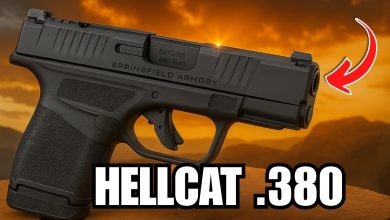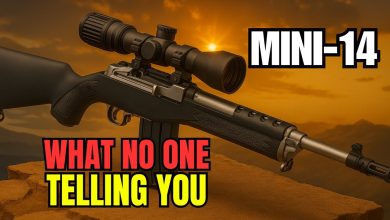Review: Springfield Armory Kuna 9mm Large-Format Pistol
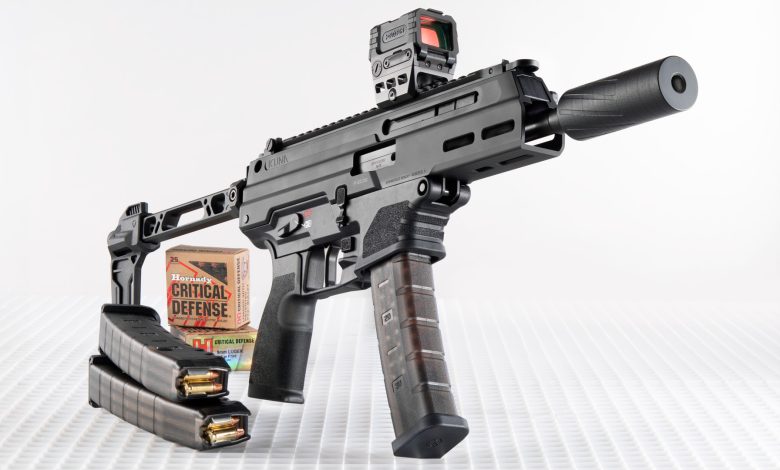
Man, I genuinely don’t know where to start on the new Kuna large-format pistol from Springfield Armory. I guess the name’s a good place: Kuna. It’s not Kona; that’s excellent Hawaiian coffee. As it turns out, “Kuna” refers to the European pine marten, a mustelid (like skunks, badgers or ferrets) common to Eastern Europe, so prevalent in Croatia (home of HS Produkt, the manufacturer of the Kuna pistol) that it was also the name for (and imprinted upon) Croatian currency. It’s small, fierce and (like most mustelids) punches above its weight class. Makes sense why Springfield Armory would want to use it to name this latest firearm.
So, what exactly is Springfield Armory’s Kuna? It is, as mentioned, a large-format, 9 mm pistol, meaning it’s heavier and longer than a traditional handgun. The magazine inserts ahead of the trigger group, similar to SMGs like the M3 Grease Gun and the Heckler & Koch MP5, with which the Kuna shares the roller-delayed operating system in addition to the layout of its controls. But, wait. Hold on a minute. Doesn’t Springfield Armory also have a large-format, 9 mm pistol in the Saint Victor family? Yes, indeed it does—but that particular firearm is AR-based and uses straight-blowback operation, not the roller-delayed system. The two also feed from different magazine types, with the Saint Victor using Colt-pattern 9 mm magazines and the Kuna’s being proprietary. Springfield Armory was tight-lipped about the magazine decision, particularly why more commonly available variants weren’t considered. However, the company is offering 30-round Kuna magazines for an eminently reasonable price, so it’s not as big of a concern as you might think.
Now, let’s go farther down the rabbit hole (but Jay, didn’t you say the kuna was a mustelid, not a lagomorph? Shaddup … ) What, exactly, is roller-delayed action? The engineers at Springfield Armory were kind enough to explain it thusly: “The roller-delayed system in the Kuna is designed to mechanically delay the rearward motion of the bolt using kinematic constraints (a roller and locking surface) which interact to impede the initial rearward motion of the bolt, converting chamber pressure and bolt thrust into delayed bolt-carrier movement, allowing chamber pressure to safely drop before extraction begins (think of it almost like a locking-bolt lug that absorbs the energy of the round going off for a split second then self-unlocks due to it “rolling” out of its locking pocket as the bolt begins to travel rearward). The result is a safer system that requires less bolt mass (which reduces recoil) and runs better in different conditions (suppressed for example).” TL/DR version: Easier shooting, less messy, more reliable. Makes sense to me.
M-Lok attachment slots grace the fore-end at the 3-, 6- and 9-o’clock positions, should lights, lasers or other accessories be desired • A proprietary muzzle brake protects the threaded muzzle • Extended, the Strike Industries’ FSA brace offers a third point-of-contact for added stability, whether held against the forearm or using a cheekweld • The brace folds to the left side of the pistol to allow for a more compact package for storage and transport.
Moving on from the operating system, the rest of the Kuna is extremely well thought out. Controls are ambidextrous—the safety selector, magazine release and bolt release are mirrored on the left- and right-hand sides. While the non-reciprocating bolt handle is located on the left side of the Kuna, it is designed to be quickly and easily swapped to the right side for left-handed shooters. Not much can be done about the ejection port, though; sorry, lefties. Both the grip (which is AR-15 compatible, so there are options if you wish to customize your Kuna with your favorite pistol grip) and the magazine well have texturing for proper hand placement; with the shorter barrel of this large-format pistol, it’s advisable to keep the support hand close to the magazine well. There’s not a ton of room at the fore-end before one runs out of upper and into barrel; best to keep digits and other fleshy bits away. If you want to use the fore-end for support, it would be exceedingly wise to add some form of hand-stop at the end of the M-Lok attachment at the 6-o’clock position. There are also M-Lok-attachment points at 3- and 9-o’clock for lights, lasers and other desired accessories.
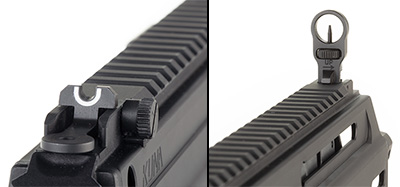
Iron sights on the Kuna can be used either raised as a peep rear/adjustable front or lowered, with a U-notch rear, white- dot front as one finds on traditional pistols.
A really cool feature of the Kuna is the front and rear sights. There are two positions available: Folded flat, they are unobtrusive and give a standard white-dot front, U-notch rear picture for close-in work. Flip up the sights and there’s a peep-sight rear with an adjustable front sight for more precise work at distance. Naturally, I ignored these awesome iron sights to put one of the new Trijicon MRO SD red-dot sights up top, because my eyesight is crap to begin with and I’m far more used to the red-dot advantage. While the flip-up sights were obscured by the MRO SD, the standard U-notch and white dot sights were quite visible and would function perfectly as a backup option. Speaking of the MRO SD, it’s designed to be used with a magnifier, and should you want an extra edge shooting steel plates at 100 yards, there’s room on the Kuna’s rail to have both the red-dot sight and magnifier. Just saying.
Up front, there’s a muzzle brake, for all the mighty power of the 9 mm cartridge. More importantly, it protects the threaded muzzle of the 6-inch barrel for when you realize that shooting unsuppressed is uncivilized and decide to add a hearing protector, also known as a sound suppressor. This is one of the big advantages of the large-format pistol, in that the shorter size makes it ideal for a suppressor without adding unwanted length for close-quarters duty. At the other end, on this particular Kuna model, is a Strike Industries’ FSA pistol-stabilizing brace. Without getting into any of the brouhaha over braced pistols, I’ll just add that the FSA really does help to stabilize the extra weight of the Kuna and makes for really fast and accurate off-hand shooting. There’s another Kuna model available without a brace, should you wish to add a different model or perhaps simply a single-point sling. That’s the beauty of capitalism: options.

At the rear of the Kuna is a short section of Picatinny rail where the brace attaches • Two, 30-round translucent magazines ship with the Kuna • Controls are ambidextrous and mirrored on both sides of the pistol • While the pistol grip is excellent, it can be swapped for most AR-15-style grips.
Wrapping up the tour of the Kuna, it’s worth noting that the charging handle folds flat against the upper receiver (which is the serialized component and therefore the actual firearm) and does not reciprocate. This means you can place your support hand (if you’re right-handed) so it wraps around the magazine well and bottom of the fore-end, with your thumb on top of the rail for a secure grip that keeps all fingers well away from the loud end. The flat-face trigger breaks cleanly with minimal take-up. Lastly, the Strike Industries’ FSA brace folds out of the way, on the left side of the Kuna, for easier transport and storage. Simply pull the brace out from the folded position to use, and lift up slightly on the brace’s arm to fold it closed.
On the range, the Kuna proved itself to be utterly reliable and quite accurate. More than 350 rounds were expended in testing, a mixture of standard lighter-weight FMJ practice ammunition, jacketed hollowpoints and some specialty ammunition. Nothing even barely phased the Kuna, it just fed, fired and ejected anything and everything I put in the magazine. That’s another advantage: Unlike standard, single-column-feed handgun magazines like those in a Glock G19, the Kuna’s mags are double-column fed, which means they are easier to load as rounds can be pressed straight in rather than maneuvered around feed lips. Toward the end of testing, there was some appreciable heat coming off the barrel, but with the generous fore-end, it never got too hot to handle.

Accuracy-wise, the Kuna punched above its weight class. Shooting results put averages at 25 yards somewhere between 1 and 2 inches, but that doesn’t tell the whole story. Two of the three loads tested had smallest groups less than 1 inch. Also, in a last-ditch effort to make the gun malfunction, I loaded both 30-round magazines with a potpourri of leftover rounds and emptied both magazines literally as quickly as I could pull the trigger (sadly, I forgot my shot timer, so I don’t have split times, but it was pretty quick). As soon as the first magazine was empty, it was replaced by the second which was fired equally rapidly. On a B-8 target, only a half-dozen rounds escaped the black, and those were on the edge of the 8- and 9-rings. This was at a distance of 10 yards, which I figured would represent the limit of a standard home-defense scenario. Putting 54 out of 60 rounds into the black as quickly as I could pull the trigger helped seal the Kuna as a solid home-defense option in my mind.
Which leads directly into the last piece of the Kuna puzzle: Where does it fit in your armory? Now, that’s certainly a loaded question, and it means different things to different people. For some, “because it’s cool and I want one” is all the justification needed—and that’s awesome. We often lose sight of the fact that shooting is fun, and that shooting different and interesting guns means we have even more fun. For the defense-minded, the Kuna is well situated as a home-defense option: With the brace as a third point-of-contact, it’s stable, accurate and reliable; pretty much the trinity of things you want in a defensive firearm. You can add a sound suppressor, light and a dot and still have a firearm shorter than the trimmest 16-inch carbine, at a weight that’s less than all but the most exotic of ARs.
Additionally, I could easily fit the Kuna into a variety of messenger bags, duffel bags and other decidedly non-gun-looking packs, which really helps keep it “gray man” when you’re on the go. Between the folding brace, 6-inch barrel and overall compactness, it does make for an easy-to-transport option if you want something more than the 10-round, micro-9 mm double stack in your waistband. Is it perfect? No, but then again, what is? Large-format pistols in rifle calibers offer more power, certainly, but with that power comes significantly more noise, felt recoil and muzzle flash.
In the end, there’s plenty of room in your gun safe for the new Springfield Armory Kuna. Whether as a home-defense option, a traveling companion or simply a conversation piece on the local steel-plate range, it works, is accurate and doesn’t take up as much space as a carbine. Brace not for you? No worries; there’s a version that comes with just the Picatinny rail at a reduced price, just perfect for a single-point sling. It’s easy to control and maneuver, ergonomics are excellent, it’s stupidly accurate and it can be customized pretty much anyway you’d like. What more could you want? And, no, before someone asks, there’s no word on a 10 mm version of the Kuna—yet.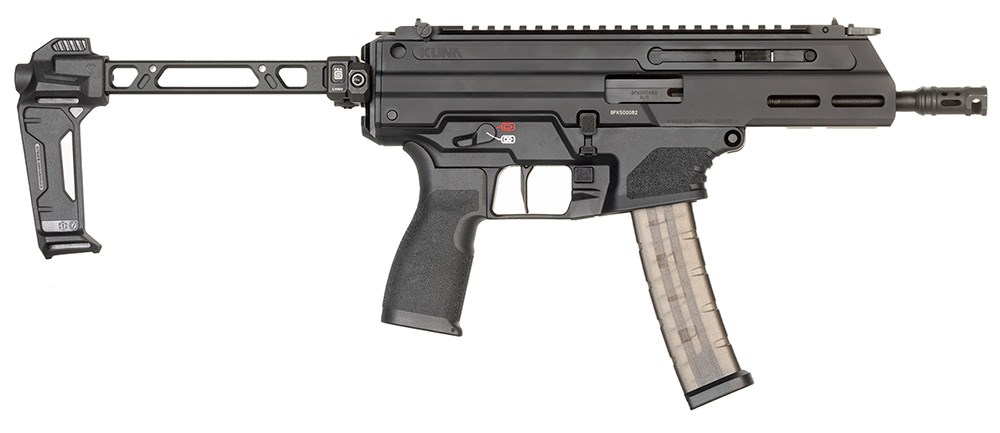
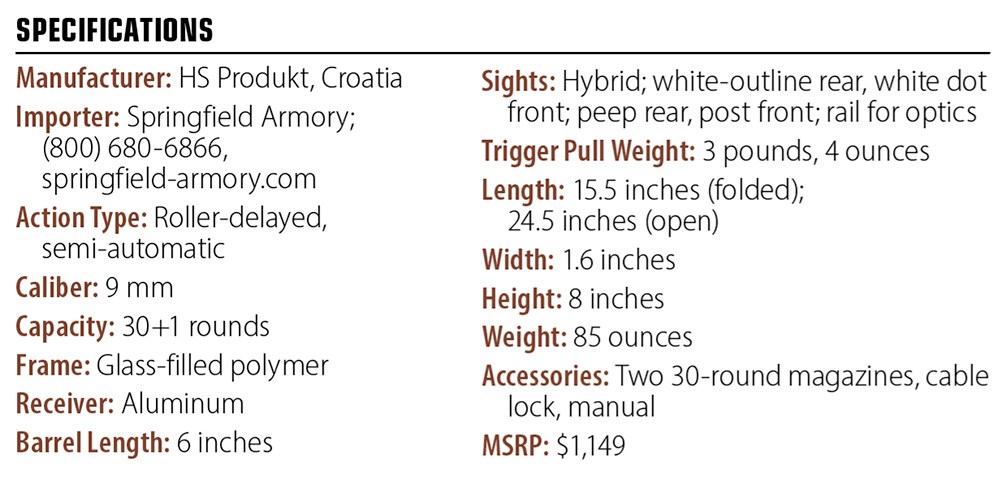
Read the full article here




